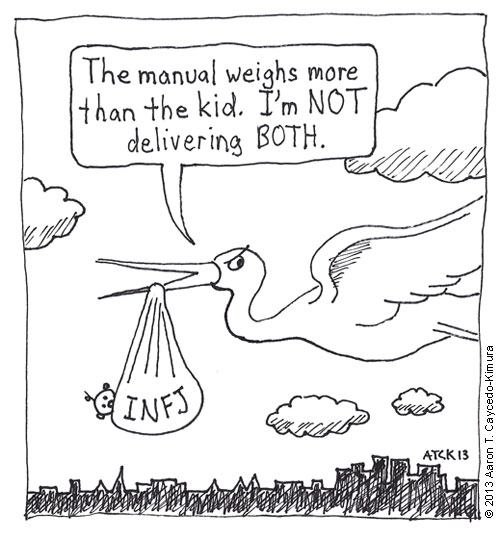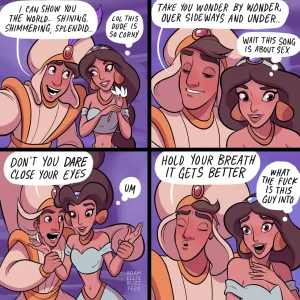Confession | Disclaimer
This is not my work, but a highjack from www.introvertdear.com
Please weigh in with thoughts about the article. I'm impassive regarding much if the information given. Please share your thoughts on the matter. Thank you
INFJ OWNERS MANUAL
As an INFJ, have you ever wished that your complex personality came with an owner’s manual? I can’t give you a comprehensive guide to understanding everything about yourself because only you can reach the depths of who you are, but I can help you understand the INFJ personality type better. As the founder of Truity, a company that helps people and organizations use personality assessments to develop their full potential, I often get questions from INFJs who want to learn more about themselves. Here are the five questions I’m asked the most frequently:
1. Do INFJs really only make up 1 percent of the population?
Let us call it “the Stat”: the notion that INFJs are the rarest personality type, making up a dismal 1 percent of the population. The Stat originated with Isabel Briggs Myers herself, based on the population of the school district where she conducted her studies in 1957. INFJ was the rarest type in one particular school. Of course, that doesn’t mean by extension the Stat is universally true everywhere.
In fact, beyond the rumor mill of the Internet, the evidence for the Stat is limited. Although some surveys have duplicated the finding, other authors have reached an entirely different conclusion about the rarest personality type. Thorne and Gough’s Portraits of Type: An MBTI Research Compendium, for example, claims that INFP/ISFP has the smallest representation across the U.S. population. The Distribution of MBTI Types in the United States by Allen Hammer and Wayne Mitchell, published in the Journal of Psychological Type, Vol. 37, 1996 found that ENFJ marginally had the smallest representation (2.45 percent of the population compared to INFJ’s 2.55 percent).
So, not every study shows INFJ as the rarest type. And because all these studies were conducted on small (and sometimes biased) samples, we really can’t be sure precisely how prevalent any type is, including INFJ.
Despite this, people are in love with the idea that INFJs are as rare as the two-horned unicorn. But this can be downright dangerous. Why? Because your rarefied status is often the only thing people remember about the INFJ type, undermining your considerable strengths and qualities. And because it knocks the bottom out of the entire personality type framework.
Personality typing is founded on the principle that no one type is better than any other. Yet many test-takers equate “rare” with “special.” They deliberately fudge their answers to earn this stamp of superiority, regardless of whether the label fits. This usurps the process of matching the person to the model and can get in the way of people recognizing their true natures.
If the INFJ label doesn’t feel like it fits, it may be time to retake the test. If, on the other hand, you experience “rarity” not as a statistic but as a sense of feeling out of step with the world, you likely are a true INFJ.
2. Why do I feel like a stranger in a strange land?
NFJs—whether extrovert or introvert—find it difficult to engage with the world. Some INFJs report feeling so detached from reality that their actions seem awkward and unnatural, like an out-of-body experience. The fact is, you feel different from the rest of the pack. This difference can make you feel incredibly isolated, even when you are surrounded by family, friends, or a roomful of INFJs who, theoretically, share the same personality traits as you do.
The problem is not, as many suggest, that INFJs are “rare” in the sense of them making up a small minority of the population. It has more to do with your complex inner world; the power exerted by your vivid imagination. Like other intuitive introverts, you can become so absorbed in your own thoughts that you are oblivious to the physical world. You feel that nobody is like you because they aren’t like you—at least in the sense that they cannot possibly speak the language of your fantasies.
How do you connect with the world? Most of us do this by reaching out to people and sharing our passions and our hungers. Sharing, however, is an extroverted function. It is not what you do best. Deeply private by nature, you may find opening up to others so challenging that you often avoid the issue and retreat to the safety of your own imagination.
Unless the conversation is about a cause you care for deeply.
When you sense an affinity with someone based on shared values and ideals, you become a warm, sensitive, and sought-after friend. But the connection has to be there. You are often guilty of throwing out perfectly healthy relationships because they fall short of your friendship gold standard: ultimate compatibility.
Until you learn to meet people halfway, finding a genuine soul mate will be tough. You will feel disconnected and lonely. This is the cross you have to bear. But when those kindred spirits do come along, you will be able to form an indelible link with them built on trust and mutual understanding. Those relationships last a lifetime.
 Enter a Breathtaking Inner World
Enter a Breathtaking Inner World
The first coloring book with an introvert theme is here. Follow an introvert and her cat as they journey through quiet, forgotten places, battle “people” overload, and seek true connection. From the creator of Introvert, Dear. Learn more.
3. What is the perfect job for an INFJ?
Your ideal career is one that expresses the four dominant aspects of your personality. Hence it would deliver:
Are you about to stop reading? You probably feel let down by this advice. Because it doesn’t resonate with you. Because it is old news.
Here’s the thing. As an INFJ, you can’t seem to shake off the sensation of uniqueness, of feeling different from the rest of the world. Reducing you to a list of “ideal” jobs feels too superficial and too generalized to be of any value. You rail against the idea of being pigeonholed to the point where no answer to this question may not ever be satisfactory. You want to crawl out of neat little boxes, not into them. You refuse to limit your potential.
So what’s the answer?
For many INFJs, it lies not in the type of job but also in the way you are permitted to perform it. Work styles that give you absolute freedom to pave our own path and deliver meaning, in the sense of fulfilling your deepest values or needs, are especially rewarding.
Entrepreneurship/freelance work fits the bill because it is service (people) oriented, yet you can create the value system, make the rules and call the shots. Other INFJs have found great success in management positions across all industries, as this allows them to solve complex problems in a logical but very kind and empathetic way. Being sensitive to the ways in which negativity can hurt people makes you really effective at dishing out constructive criticism—just the ticket for effective management.
Top Jobs for INFJs, Work Style, and INFJs as Leaders can give you more insights. Or check out Four Hot Careers for INFJs.
4. How do I handle being so empathetic all the time? It’s quite exhausting.
Personality theorists describe you as a Counselor, an Advocate or a Humanitarian, the champion of the oppressed and the downtrodden. You recognize and carry the emotional baggage of others. When you feel, you feel so deeply that other people’s problems might as well be your own. Sometimes you can’t even watch a horror film or news program without reacting negatively to the terrible things you have seen.
These things happen because you are deeply empathetic. An empath is a person who feels exactly what other people feel, even if they have no direct experience of the situation. INFJs often are so finely tuned to other people’s energy waves that they find themselves being unconsciously influenced by unwanted desires, moods, and wishes. And it can be exhausting.
While empathy has its benefits, for your own sanity you need to learn how to detach from other people’s problems before you become completely overwhelmed. There are various ways you can do this:
5. What are the best ways for an INFJ to be a leader while at the same time staying true to the core of their personality?
Reading this, you might be shocked that anyone could imagine the quiet, thoughtful INFJ as much of a leader. You are so used to being the black sheep, the outsider walking to the beat of your own drum, that you may not have considered your leadership potential let alone started honing those skills. Yet INFJs were born for leadership. Mahatma Gandi didn’t do so bad when he led an entire nation to independence in British-ruled India.
As with any role or profession, the key to success is staying true to yourself. You will not demonstrate the same behaviors as a conventional leader, such as the ENTJ, but you do possess the qualities you need to lead effectively. Here’s how you can excel:
Lead by example. Because you genuinely care about people and whether or not they are happy, you will never ask anyone to do something you would not do yourself. People will work hard for you because they trust and respect your ethics and judgment.
Focus on the human side of business. You are empathetic and compassionate and these skills make you a supportive and appreciative leader. You inspire and motivate people. You encourage them to reach their full potential. These rewards are known to boost an individual’s creativity and productivity, such that the team you lead is likely to be greater than the sum of its parts.
Collaborate. INFJs are not the type of boss to shout commands from the corner office. You involve the team in decision-making and encourage people to look for solutions together. When things go wrong, you do not waste time looking for someone to blame. Instead you focus your energy on improving the process, to avoid making the same mistake again and to minimize conflict.
On the downside, you can experience enormous distress when organizational processes get in the way of human needs. Invariably, this will happen and you will need to develop coping techniques. Also, you have a habit of feeling overwhelmed—paralyzed even—when you cannot resolve all the problems you see.
Remember, “Mile by mile it’s a trial; yard by yard it’s hard; but inch by inch it’s a cinch.” This is a good mantra for the INFJ leader, and one that will stand you in good stead as you strive to evolve as a leader and as a human being.
Want to know more? Check out Four Ways Introverted Leaders Can Make The Most of Their Strengths.
For more information on making the most of your INFJ strengths, check out Truity’s ebook, The True INFJ.
This is not my work, but a highjack from www.introvertdear.com
Please weigh in with thoughts about the article. I'm impassive regarding much if the information given. Please share your thoughts on the matter. Thank you
INFJ OWNERS MANUAL
As an INFJ, have you ever wished that your complex personality came with an owner’s manual? I can’t give you a comprehensive guide to understanding everything about yourself because only you can reach the depths of who you are, but I can help you understand the INFJ personality type better. As the founder of Truity, a company that helps people and organizations use personality assessments to develop their full potential, I often get questions from INFJs who want to learn more about themselves. Here are the five questions I’m asked the most frequently:
1. Do INFJs really only make up 1 percent of the population?
Let us call it “the Stat”: the notion that INFJs are the rarest personality type, making up a dismal 1 percent of the population. The Stat originated with Isabel Briggs Myers herself, based on the population of the school district where she conducted her studies in 1957. INFJ was the rarest type in one particular school. Of course, that doesn’t mean by extension the Stat is universally true everywhere.
In fact, beyond the rumor mill of the Internet, the evidence for the Stat is limited. Although some surveys have duplicated the finding, other authors have reached an entirely different conclusion about the rarest personality type. Thorne and Gough’s Portraits of Type: An MBTI Research Compendium, for example, claims that INFP/ISFP has the smallest representation across the U.S. population. The Distribution of MBTI Types in the United States by Allen Hammer and Wayne Mitchell, published in the Journal of Psychological Type, Vol. 37, 1996 found that ENFJ marginally had the smallest representation (2.45 percent of the population compared to INFJ’s 2.55 percent).
So, not every study shows INFJ as the rarest type. And because all these studies were conducted on small (and sometimes biased) samples, we really can’t be sure precisely how prevalent any type is, including INFJ.
Despite this, people are in love with the idea that INFJs are as rare as the two-horned unicorn. But this can be downright dangerous. Why? Because your rarefied status is often the only thing people remember about the INFJ type, undermining your considerable strengths and qualities. And because it knocks the bottom out of the entire personality type framework.
Personality typing is founded on the principle that no one type is better than any other. Yet many test-takers equate “rare” with “special.” They deliberately fudge their answers to earn this stamp of superiority, regardless of whether the label fits. This usurps the process of matching the person to the model and can get in the way of people recognizing their true natures.
If the INFJ label doesn’t feel like it fits, it may be time to retake the test. If, on the other hand, you experience “rarity” not as a statistic but as a sense of feeling out of step with the world, you likely are a true INFJ.
2. Why do I feel like a stranger in a strange land?
NFJs—whether extrovert or introvert—find it difficult to engage with the world. Some INFJs report feeling so detached from reality that their actions seem awkward and unnatural, like an out-of-body experience. The fact is, you feel different from the rest of the pack. This difference can make you feel incredibly isolated, even when you are surrounded by family, friends, or a roomful of INFJs who, theoretically, share the same personality traits as you do.
The problem is not, as many suggest, that INFJs are “rare” in the sense of them making up a small minority of the population. It has more to do with your complex inner world; the power exerted by your vivid imagination. Like other intuitive introverts, you can become so absorbed in your own thoughts that you are oblivious to the physical world. You feel that nobody is like you because they aren’t like you—at least in the sense that they cannot possibly speak the language of your fantasies.
How do you connect with the world? Most of us do this by reaching out to people and sharing our passions and our hungers. Sharing, however, is an extroverted function. It is not what you do best. Deeply private by nature, you may find opening up to others so challenging that you often avoid the issue and retreat to the safety of your own imagination.
Unless the conversation is about a cause you care for deeply.
When you sense an affinity with someone based on shared values and ideals, you become a warm, sensitive, and sought-after friend. But the connection has to be there. You are often guilty of throwing out perfectly healthy relationships because they fall short of your friendship gold standard: ultimate compatibility.
Until you learn to meet people halfway, finding a genuine soul mate will be tough. You will feel disconnected and lonely. This is the cross you have to bear. But when those kindred spirits do come along, you will be able to form an indelible link with them built on trust and mutual understanding. Those relationships last a lifetime.
 Enter a Breathtaking Inner World
Enter a Breathtaking Inner WorldThe first coloring book with an introvert theme is here. Follow an introvert and her cat as they journey through quiet, forgotten places, battle “people” overload, and seek true connection. From the creator of Introvert, Dear. Learn more.
3. What is the perfect job for an INFJ?
Your ideal career is one that expresses the four dominant aspects of your personality. Hence it would deliver:
- Substantial intellectual work (an I preference)
- Creativity and the ability to explore wider problems (an N preference)
- Making a difference in the lives of other people (an F preference)
- A well-defined and structured work style (a J preference).
Are you about to stop reading? You probably feel let down by this advice. Because it doesn’t resonate with you. Because it is old news.
Here’s the thing. As an INFJ, you can’t seem to shake off the sensation of uniqueness, of feeling different from the rest of the world. Reducing you to a list of “ideal” jobs feels too superficial and too generalized to be of any value. You rail against the idea of being pigeonholed to the point where no answer to this question may not ever be satisfactory. You want to crawl out of neat little boxes, not into them. You refuse to limit your potential.
So what’s the answer?
For many INFJs, it lies not in the type of job but also in the way you are permitted to perform it. Work styles that give you absolute freedom to pave our own path and deliver meaning, in the sense of fulfilling your deepest values or needs, are especially rewarding.
Entrepreneurship/freelance work fits the bill because it is service (people) oriented, yet you can create the value system, make the rules and call the shots. Other INFJs have found great success in management positions across all industries, as this allows them to solve complex problems in a logical but very kind and empathetic way. Being sensitive to the ways in which negativity can hurt people makes you really effective at dishing out constructive criticism—just the ticket for effective management.
Top Jobs for INFJs, Work Style, and INFJs as Leaders can give you more insights. Or check out Four Hot Careers for INFJs.
4. How do I handle being so empathetic all the time? It’s quite exhausting.
Personality theorists describe you as a Counselor, an Advocate or a Humanitarian, the champion of the oppressed and the downtrodden. You recognize and carry the emotional baggage of others. When you feel, you feel so deeply that other people’s problems might as well be your own. Sometimes you can’t even watch a horror film or news program without reacting negatively to the terrible things you have seen.
These things happen because you are deeply empathetic. An empath is a person who feels exactly what other people feel, even if they have no direct experience of the situation. INFJs often are so finely tuned to other people’s energy waves that they find themselves being unconsciously influenced by unwanted desires, moods, and wishes. And it can be exhausting.
While empathy has its benefits, for your own sanity you need to learn how to detach from other people’s problems before you become completely overwhelmed. There are various ways you can do this:
- Set and defend your boundaries. Saying “no” is hard for an INFJ, because you feel guilty about hurting people’s feelings. But sometimes, the only winning move is not to play the game. Set time limits for the amount of social interaction you can deal with, and back off completely when it gets to be too much.
- Take some alone time. As an introvert, you need extended time alone to refresh and recalibrate.
- Return the emotional baggage. Reflecting feelings back to the originator can help minimize the burden you are carrying. Practice saying, “I can tell you’re feeling xyz right now. What do you think you could do to help yourself feel better?”
- Shield. A recent study published in Neuroimage suggests that people can’t perform empathetic and logical thinking at the same time; they mutually inhibit one another. The shielding technique requires you to turn down your empathetic F side and turn up your decisive J side. Focus on helping the people around you take productive action. This will press you into logical thinking and help block out the overwhelming effects of your empathizing.
5. What are the best ways for an INFJ to be a leader while at the same time staying true to the core of their personality?
Reading this, you might be shocked that anyone could imagine the quiet, thoughtful INFJ as much of a leader. You are so used to being the black sheep, the outsider walking to the beat of your own drum, that you may not have considered your leadership potential let alone started honing those skills. Yet INFJs were born for leadership. Mahatma Gandi didn’t do so bad when he led an entire nation to independence in British-ruled India.
As with any role or profession, the key to success is staying true to yourself. You will not demonstrate the same behaviors as a conventional leader, such as the ENTJ, but you do possess the qualities you need to lead effectively. Here’s how you can excel:
Lead by example. Because you genuinely care about people and whether or not they are happy, you will never ask anyone to do something you would not do yourself. People will work hard for you because they trust and respect your ethics and judgment.
Focus on the human side of business. You are empathetic and compassionate and these skills make you a supportive and appreciative leader. You inspire and motivate people. You encourage them to reach their full potential. These rewards are known to boost an individual’s creativity and productivity, such that the team you lead is likely to be greater than the sum of its parts.
Collaborate. INFJs are not the type of boss to shout commands from the corner office. You involve the team in decision-making and encourage people to look for solutions together. When things go wrong, you do not waste time looking for someone to blame. Instead you focus your energy on improving the process, to avoid making the same mistake again and to minimize conflict.
On the downside, you can experience enormous distress when organizational processes get in the way of human needs. Invariably, this will happen and you will need to develop coping techniques. Also, you have a habit of feeling overwhelmed—paralyzed even—when you cannot resolve all the problems you see.
Remember, “Mile by mile it’s a trial; yard by yard it’s hard; but inch by inch it’s a cinch.” This is a good mantra for the INFJ leader, and one that will stand you in good stead as you strive to evolve as a leader and as a human being.
Want to know more? Check out Four Ways Introverted Leaders Can Make The Most of Their Strengths.
For more information on making the most of your INFJ strengths, check out Truity’s ebook, The True INFJ.





